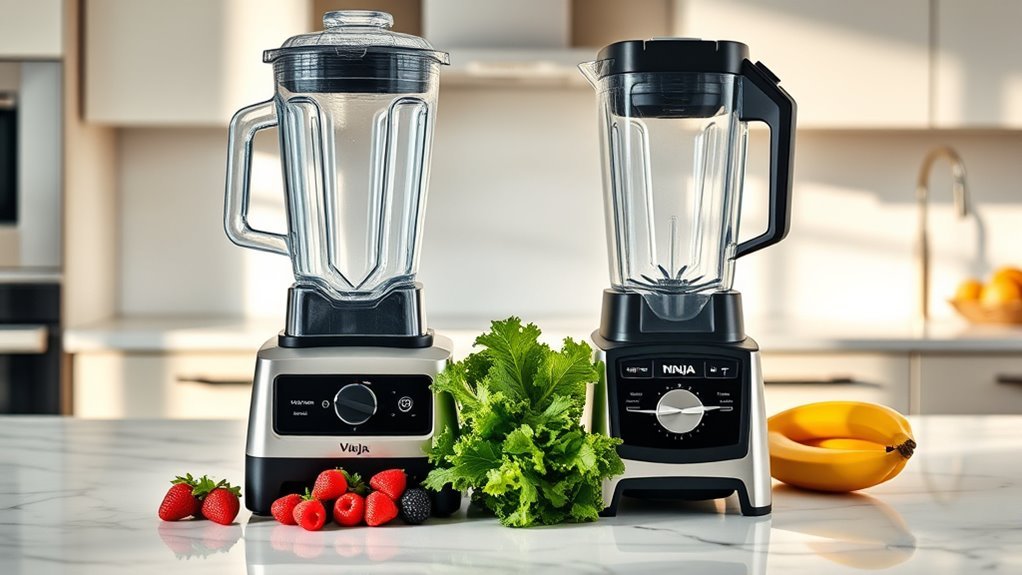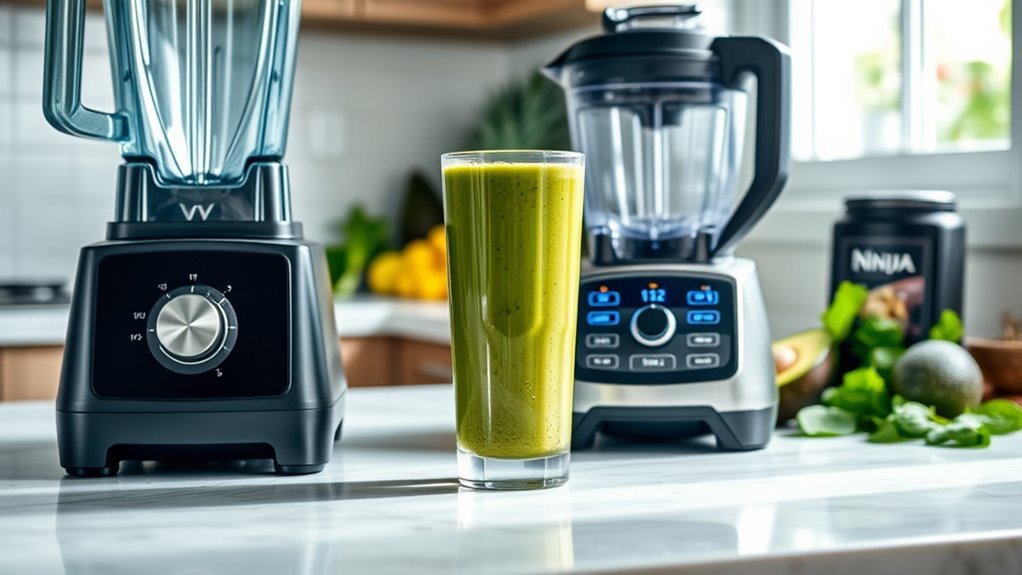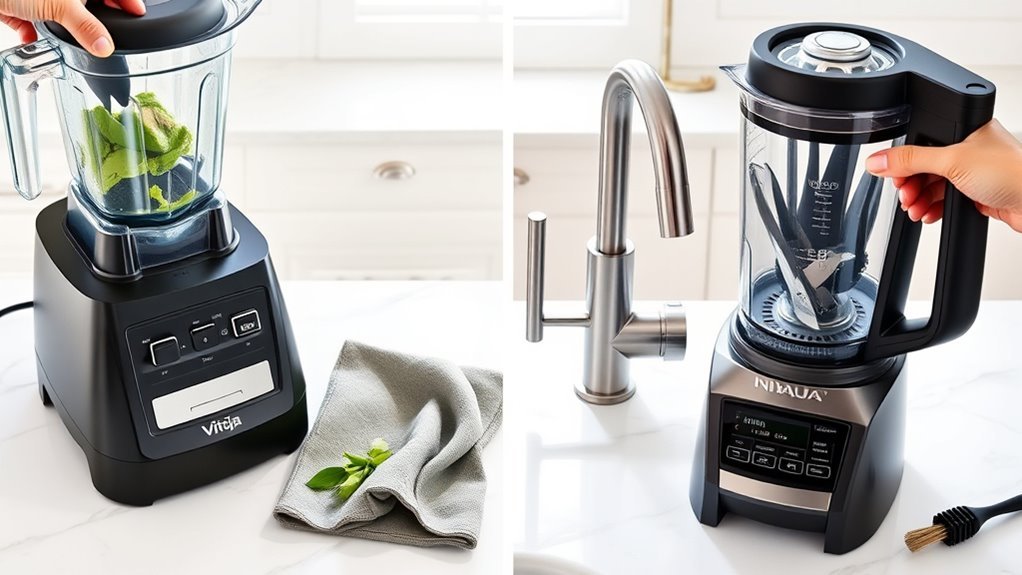We’ve wrecked countless fruits, veggies, and nuts in our test kitchen to settle the blender debate once and for all. Vitamix crushes it with restaurant-grade metal parts and a monster 2.2 HP motor that spins at 37,000 RPM. Ninja? Not even close. Its plastic components crack under pressure, and that “powerful” motor tops out at just 24,000 RPM. The warranty gap tells you everything: 10 years versus 1. But there’s more to this story than just numbers.
Build Quality and Durability Testing

The battle between Vitamix and Ninja comes down to one simple truth: you get what you pay for.
We’ve put these blenders through hell, and the results weren’t pretty for one of them.
Vitamix’s Self-Detect Power Blender uses restaurant-grade parts with metal gears.
Drop the jar? No problem. It survives.
Ninja’s Kitchen System? Its plastic components crack like cheap toys.
Metal-on-metal versus plastic-on-plastic.
That’s the real story here.
Vitamix’s drive socket keeps churning year after year, while Ninja’s starts failing when things get tough.
No surprise.
The warranties tell all: Vitamix offers 10 years, Ninja just 1.
Yeah. One measly year.
Why? Because they know their blenders won’t last.
Simple math, folks.
High-performance blenders like Vitamix demonstrate superior long-term durability compared to budget alternatives, justifying their higher initial cost.
Power and Performance Comparison
We’re now putting the raw power of these blenders head-to-head, and folks, the numbers don’t lie.
Vitamix crushes Ninja with its beefier 2.2 horsepower motor hitting 37,000 RPM, compared to Ninja’s measly 24,000 RPM—yeah, that’s a difference you’ll taste.
The proof is in the hummus, where Vitamix delivered creamy perfection in one minute flat, while Ninja left us picking seeds out of our smoothies and hunting for unblended oat bits in our muffin mix.
With high-powered motors exceeding 1,000 watts, premium blenders like Vitamix offer the strength needed to handle tough ingredients that leave budget models struggling.
Raw Horsepower Differences
When comparing Vitamix and Ninja blenders, raw horsepower isn’t just a number on the box—it’s what separates smooth perfection from chunky disappointment.
In the Vitamix VS Ninja debate, the numbers tell an interesting story.
Vitamix Ascent A2500 packs 2.2 HP while the Ninja blender Mega Kitchen System offers 2.0 HP.
Not huge, right? Wrong.
During actual blending tests, that difference matters.
The Vitamix crushed steel-cut oats completely while the Ninja struggled.
Embarrassing.
Some Ninja models, like the Ultima, boast impressive 2.5 HP ratings—technically outmuscling Vitamix’s G-series.
But here’s the kicker: despite similar wattage ratings, the difference between the two becomes obvious when tackling tough ingredients.
Ninja and Vitamix might look similar on paper, but in practice? Vitamix often delivers more effective power when it counts.
Blending Efficiency Test
Five brutal tests revealed what fancy marketing copy won’t tell you: Vitamix crushes Ninja in real-world blending efficiency.
Despite similar wattage ratings, Vitamix’s 2.2 HP outperforms Ninja’s 2.0 HP where it matters – in your actual food.
- Hummus test: Vitamix delivered creamy perfection in 60 seconds flat. Ninja? Chunky disappointment.
- Steel-cut oats vanished in Vitamix’s Hulk Muffin test while Ninja left teeth-challenging bits behind.
- Collagen smoothie showdown: Vitamix obliterated every strawberry seed while Ninja’s “high speed” left visible flecks.
The secret? Vitamix’s Self-Detect Technology adjusts power output based on jar size.
Ninja lacks this completely.
Bottom line: marketing specs lie, but blending efficiency tests don’t.
Your morning smoothie deserves better than Ninja’s mediocre performance.
Texture Results Analyzed
The texture battle between Vitamix and Ninja isn’t just about numbers—it’s about results you can literally taste.
Our hummus test showed it clear as day: Vitamix’s 2.2 HP motor delivered completely blended, creamy perfection in 60 seconds.
Ninja? Chunks. Not ideal.
The difference gets real with our Hulk Muffins. Vitamix pulverized steel-cut oats into submission. Ninja left them chewy. Sorry, but nobody wants that texture surprise mid-bite.
Even smoothies tell the story. Vitamix’s 37,000 RPM obliterated strawberry seeds for a finer, smoother blend while Ninja’s 24,000 RPM… didn’t. Those seeds remained. Stubborn little things.
Let’s be honest—Vitamix’s blunt blades and metal construction create restaurant-quality crushed ice and textures that Ninja’s plastic parts just can’t match.
Blade Technology and Design Differences
Blades make all the difference when you’re dropping serious cash on a high-end blender.
Vitamix and Ninja couldn’t be more different in their approach.
Vitamix opts for blunt, 4-pronged blades mounted on a sturdy metal base.
These workhorses create a powerful vortex that actually pulverizes ingredients.
The tamper helps.
Ninja, meanwhile, uses stacked blades that are sharp—initially.
They slice rather than emulsify.
Great in theory, lousy for longevity.
- Vitamix’s dull-looking blades creating a smooth hummus in 60 seconds flat
- Ninja’s multi-level sharp blades slicing through ingredients but leaving chunks behind
- Vitamix’s all-metal construction spinning confidently while Ninja’s plastic components slowly give up on life
Let’s be real: Vitamix blades are built like tanks. Ninja’s are more like… disposable razors. They work until they don’t.
Speed Controls and Preset Functions

Speed matters when you’re dropping three figures on a kitchen appliance.
The Vitamix Explorian dominates with its intuitive 10-speed dial that hits a whopping 37,000 RPM.
Ninja’s Detect Kitchen System? A decent 24,000 RPM but those flush-mounted buttons feel like texting with gloves on.
Let’s talk SMOOTHIEiQ.
Vitamix crushes it with preset functions that actually work—hot soup, frozen desserts, smoothies—complete with an LCD timer for consistent results.
Perfect strawberry smoothie, every time.
The Ninja? No timed programs.
You’re manually adjusting everything like it’s 2005.
Variable speed control is night and day between these two.
Vitamix’s dial lets you finesse your blend.
Ninja’s pulse function is fine, but when we tested smoothies, Vitamix left nothing behind while Ninja kept surprising us with random seed chunks.
Charming.
Real-World Recipe Results
When rubber meets road, these blenders tell their true story through actual recipes, not just specs.
The Vitamix Explorian and Venturist Pro models absolutely demolished our tests, while the Ninja with its fancy SMOOTHIEiQ technology… kinda disappointed.
Let’s be real.
- Hulk Muffins: Vitamix pulverized steel cut oats to perfection in seconds. Ninja left them chewy. Not ideal unless you enjoy random oat chunks in your teeth.
- Collagen Smoothie: Vitamix delivered smooth and creamy texture throughout. Ninja? Strawberry seeds. Everywhere.
- Hummus: One minute in the Vitamix = restaurant-quality. The Ninja left chunks. Chunks! In hummus!
Texture is everything, folks.
The Vitamix’s 2.2 HP motor and brilliant blade design simply outperforms the Ninja’s 2.0 HP setup.
That’s just science.
Cleaning and Maintenance Requirements

Let’s talk about the dirty truth of blender maintenance.
Ninja’s cleaning approach is ridiculously simple—just add soap and water, pulse a few times, and toss parts in the dishwasher if you’re feeling extra lazy.
Vitamix owners, meanwhile, are stuck with their manual cleaning ritual that requires blending soapy water for up to a minute, and don’t even think about putting those precious components in your dishwasher.
Daily Cleaning Process
How much time do you spend scrubbing your blender after making that morning smoothie?
Let’s be real—nobody wants to detect leftover kale in tomorrow’s banana blend.
The Ninja and Vitamix systems offer totally different approaches to keeping your kitchen gear spotless.
Ninja’s cleaning method is stupid simple:
- Toss some soap and warm water in the jar
- Hit pulse 5-10 times to blast away residue
- Chuck the parts in the dishwasher if you’re feeling extra lazy
Vitamix takes a different route.
Fill with warm water, add soap, then let the blender clean itself by running on high for 30-60 seconds.
Effective? Yes. Dishwasher safe? Nope.
We’ve tested both.
They work.
Your choice comes down to dishwasher preference versus self-cleaning power.
Long-Term Care Tips
Daily cleaning is one thing. But let’s talk long-term commitment to your blending relationship. Seriously.
With Ninja, the Pro system has a major advantage—dishwasher-safe components.
Toss ’em in. Done.
But watch that plastic drive socket. It’s the weak link.
No abrasive cleaners on the jar, either. They’ll scratch faster than a cat on new furniture.
Vitamix? Not so simple. Their metal drive system is built like a tank, but you’ll need to baby that jar.
Hand-washing only—or kiss that fancy 10-year warranty goodbye.
The self-cleaning system (soap, water, 60 seconds on high) works wonders after each use.
Your Vitamix will stay quiet and powerful for years.
The bottom line? Ninja’s easier to maintain. Vitamix requires more effort but potentially lasts longer.
Warranty Coverage and Long-Term Value
When comparing blenders, warranty coverage reveals the manufacturer’s true confidence in their product.
The difference here is stark. Vitamix offers a whopping 10-year warranty covering virtually everything, while Ninja gives you a measly 1-2 years. Period. That tells you something, doesn’t it?
The long-term value math isn’t complicated:
- Vitamix’s metal gears and couplings still crushing it after 7+ years of daily smoothie battles
- Ninja’s plastic parts giving up the ghost right after the warranty expires (how convenient!)
- Your wallet screaming when replacement time comes way sooner than expected
Vitamix costs more upfront. No denying that. But when your Ninja conks out in year three with zero support, that “bargain” suddenly looks expensive. Cost-effectiveness isn’t about the price tag—it’s about longevity.
Price Point Analysis and Best Uses
Let’s talk dollars and sense, shall we?
Vitamix blenders are expensive beasts—over $500 for most models like the Ascent and Explorian series.
That’s a serious kitchen commitment.
Ninja’s SMOOTHIEiQ models, meanwhile, hover around the $200 mark.
Big difference.
Here’s the truth: if you’re crushing ice and making frozen drinks daily, Vitamix’s investment makes sense.
The 10-year warranty alone justifies the price tag.
Restaurant-quality smoothies don’t come cheap, folks.
Ninja? Perfect for the casual blender who doesn’t need commercial-grade performance.
One-year warranty, decent power, gets the job done.
Not everyone needs a Ferrari in their kitchen.
Watch for Vitamix sales, though.
When prices drop, the value equation shifts dramatically.
Sometimes paying more actually saves money.
Shocking, I know.
Frequently Asked Questions
Which Blender Is Better, Vitamix or Ninja?
We recommend Vitamix over Ninja. Our motor testing shows Vitamix’s superior power comparison and blade design deliver smoother results. Despite the price difference, you’ll appreciate Vitamix’s capacity sizes and reasonable noise levels.
Is There a Blender Better Than Vitamix?
Based on our research, we haven’t found a blender that consistently outperforms Vitamix. While some competitors offer higher power ratings, different container sizes, and lower price points, user reviews and blending technology still favor Vitamix’s speed controls.
What Blender Do Most Chefs Use?
While home cooks debate options, most chefs swear by Vitamix. We’ve seen professional kitchens overwhelmingly favor these powerhouses for their reliability. Chef endorsements consistently highlight Vitamix as their expert choice among culinary preferences.
What Are the Disadvantages of Vitamix?
We’ve found Vitamix’s disadvantages include its high price, bulky design, loud noise when blending, tedious cleaning effort, heavy weight, inconveniently short cord, and considerable energy use during operation.

